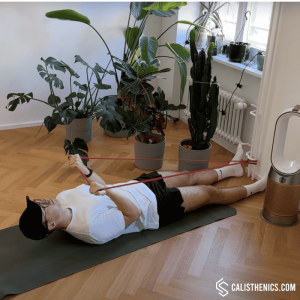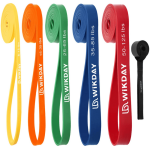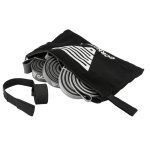Lying Resistance Band Biceps Curls
How to do Lying Resistance Band Biceps Curls?
Lying resistance band bicep curls are a variation of the traditional curl performed while lying on the floor, with a resistance band anchored below the feet. This exercise targets the biceps in a unique way, as the resistance increases as you approach the peak of the curl, creating a different tension profile compared to dumbbell curls. By lying on your back, you reduce the risk of using momentum, ensuring that the biceps are fully engaged. This exercise is great for building arm strength, stability, and endurance.
Steps to Perform a Proper Lying Resistance Band Bicep Curl:
1. Anchor the Resistance Band:
• Secure the resistance band to a stable point below your feet (e.g., a heavy object or door anchor at the bottom).
• Lie on your back on a mat with your head positioned away from the anchor point, ensuring there’s slight tension in the band with your arms extended.
2. Grip the Band and Set Up Your Position:
• Hold each end of the resistance band with your palms facing up, arms extended straight toward the anchor point.
• Keep your elbows close to your sides, and ensure your wrists remain in a neutral position (aligned with your forearm).
3. Engage Your Core and Prepare for the Curl:
• Tighten your core by pulling your belly button toward your spine to keep your back flat against the floor.
• Maintain a fixed elbow position throughout the curl to keep the focus on your biceps.
4. Curl the Band Toward Your Shoulders:
• Exhale as you bend your elbows and curl the band up toward your shoulders, focusing on squeezing your biceps at the top.
• Move slowly and with control, avoiding any momentum to ensure full engagement of the biceps.
5. Slowly Lower Back to the Starting Position:
• Inhale as you extend your arms back to the starting position, keeping tension in the band throughout.
• Stop just before your arms are fully straight to keep constant tension on your biceps.
6. Repeat the Movement:
• Perform the desired number of repetitions, focusing on smooth, controlled movements throughout each rep.
Benefits of Resistance Band Bicep Curls vs. Dumbbell Curls
• Variable Resistance: With resistance bands, the tension increases as you stretch the band further, meaning that the resistance is highest at the peak of the movement. This allows for a more intense contraction at the top of the curl compared to dumbbells, where resistance remains constant throughout.
• Improved Range of Motion: Resistance bands offer more freedom in movement than fixed weights, allowing you to customize the angle of your curl and potentially target the biceps differently.
• Reduced Joint Impact: Bands provide a smooth and continuous resistance, reducing the impact on joints. This can be especially beneficial for people recovering from injuries or with joint concerns.
• Easier on the Lower Back: The lying position with bands eliminates the need for stabilizing the upper body, reducing strain on the lower back and allowing for pure bicep engagement.
• Portability and Convenience: Resistance bands are lightweight, portable, and easy to use anywhere, unlike dumbbells, which are heavier and require specific weights for different intensities.
• Lower Risk of Momentum: The gradual resistance of bands helps prevent the use of momentum, ensuring controlled and focused movement, which can be more difficult to maintain with dumbbells, especially as weights increase.
Common Mistakes to Avoid
• Using Momentum: Avoid swinging or jerking to bring the band up. Focus on slow, controlled movements to keep the biceps engaged.
• Allowing the Elbows to Move: Keep your elbows close to your body and stable throughout the exercise to prevent shoulder involvement.
• Hyperextending the Wrist: Maintain a neutral wrist position to avoid straining your wrist and keep the focus on the biceps.
• Arching the Back: Keep your back flat on the floor and your core engaged to prevent strain on your lower back.
• Releasing the Band Too Quickly: Control the movement on the way down to keep tension in the biceps and increase muscle engagement.
Tips for the proper execution of Lying Resistance Band Biceps Curls
Keep the Elbows Fixed: Your elbows should remain close to your body and stable throughout the exercise, ensuring isolation of the biceps.
Control the Speed: Avoid using quick movements; perform the exercise slowly to maximize muscle engagement.
Breathe Steadily: Exhale as you curl up and inhale as you lower back down. Controlled breathing helps maintain stability and muscle focus.
Maintain a Neutral Wrist: Keep your wrist aligned with your forearm, avoiding any forward or backward bend to reduce strain and maintain bicep focus.
Engage the Core: Keep your core tight to prevent your lower back from lifting off the floor, enhancing stability and form.
Muscles worked when doing Lying Resistance Band Biceps Curls
Primary Muscles:
•Biceps Brachii: The main muscle responsible for elbow flexion and the primary target of this exercise.
Secondary Muscles:
•Forearms: The forearm muscles assist in grip and control during the curl.
•Core: The abdominals engage to stabilize the torso and prevent the lower back from lifting off the floor.
•Shoulders: The shoulders stabilize the arm position, although they remain passive to avoid contributing to the curl.
Primary Muscle(s):
Secondary Muscle(s):

Forearm
Adjust the difficulty of Lying Resistance Band Biceps Curls
How to make Lying Resistance Band Biceps Curls harder?
How to make Lying Resistance Band Biceps Curls easier?
How to make Lying Resistance Band Biceps Curls harder?
To make Lying Resistance Band Biceps Curls harder:
-
Use a Heavier Resistance Band: Increase the difficulty by using a band with more resistance, challenging your biceps further.
-
Increase Time Under Tension: Slow down the movement, especially on the way down, to increase muscle engagement and build endurance.
-
Add a Pause at the Top: Pause for 2-3 seconds at the peak of the curl, maximizing time under tension and engaging the biceps fully.
-
Increase Repetitions or Sets: Add more repetitions or sets to challenge your endurance and build strength.
How to make Lying Resistance Band Biceps Curls easier?
To make Lying Resistance Band Biceps Curls easier:
-
Use a Lighter Resistance Band: Choose a band with less resistance to make the movement easier and allow you to focus on form.
-
Limit Range of Motion: Perform partial curls, bending only halfway, to reduce intensity and build strength gradually.
-
Perform Fewer Repetitions: Start with a smaller number of repetitions (e.g., 8-10) and increase as you build strength.





